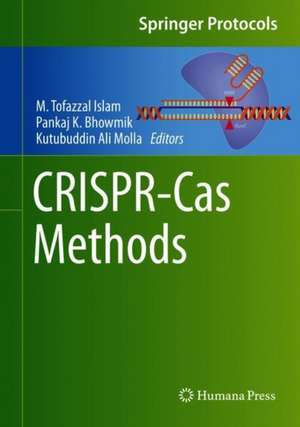CRISPR-Cas Methods: Springer Protocols Handbooks
Editat de M. Tofazzal Islam, Pankaj K. Bhowmik, Kutubuddin A. Mollaen Limba Engleză Hardback – 30 iun 2020
This volume details the fundamentals of the CRISPR-Cas system, and its protocols illustrate advances in CRISPR-Cas techniques for efficient genome editing. Introductory chapters provide a wide horizon of CRISPR/Cas-based methods and applications. Additional chapters guide readers through HDR-mediated editing, sgRNA design, the step-by-step procedure of multiplex adenine base editing experiments in rice, generating mutants for rice, wheat, Brachypodium, Barley, Flax, and Phytophthora, visual screening of mutants, gene deletion (knock-out), tagging (knock-in) in mammalian cells, the cloning-free (DNA-free) technique, cell-penetrating peptides, generating a genome-edited banana, and nuclear genome editing of Chlamydomonas employing CRISPR-Cpf1 combined with a single-stranded DNA (ssODN) repair template.
Authoritative and cutting-edge, CRISPR-Cas Methods aims to assist researchers who are new to the field and are aiming to learn how best to adopt this technology for a particular organism.
| Toate formatele și edițiile | Preț | Express |
|---|---|---|
| Paperback (1) | 630.36 lei 38-44 zile | |
| Springer Us – 5 iul 2020 | 630.36 lei 38-44 zile | |
| Hardback (1) | 1041.71 lei 38-44 zile | |
| Springer Us – 30 iun 2020 | 1041.71 lei 38-44 zile |
Din seria Springer Protocols Handbooks
- 18%
 Preț: 782.42 lei
Preț: 782.42 lei - 5%
 Preț: 1817.13 lei
Preț: 1817.13 lei - 18%
 Preț: 1120.18 lei
Preț: 1120.18 lei -
 Preț: 403.91 lei
Preț: 403.91 lei - 15%
 Preț: 662.30 lei
Preț: 662.30 lei - 18%
 Preț: 1855.11 lei
Preț: 1855.11 lei - 18%
 Preț: 1918.09 lei
Preț: 1918.09 lei - 18%
 Preț: 896.08 lei
Preț: 896.08 lei - 15%
 Preț: 644.82 lei
Preț: 644.82 lei - 20%
 Preț: 593.48 lei
Preț: 593.48 lei - 18%
 Preț: 966.27 lei
Preț: 966.27 lei - 5%
 Preț: 2329.29 lei
Preț: 2329.29 lei - 18%
 Preț: 952.09 lei
Preț: 952.09 lei - 5%
 Preț: 737.11 lei
Preț: 737.11 lei - 15%
 Preț: 648.24 lei
Preț: 648.24 lei - 18%
 Preț: 984.44 lei
Preț: 984.44 lei - 18%
 Preț: 977.34 lei
Preț: 977.34 lei - 18%
 Preț: 1674.20 lei
Preț: 1674.20 lei - 18%
 Preț: 1841.06 lei
Preț: 1841.06 lei - 18%
 Preț: 970.87 lei
Preț: 970.87 lei - 18%
 Preț: 1588.19 lei
Preț: 1588.19 lei - 18%
 Preț: 1029.13 lei
Preț: 1029.13 lei - 5%
 Preț: 677.07 lei
Preț: 677.07 lei - 18%
 Preț: 1250.74 lei
Preț: 1250.74 lei - 5%
 Preț: 723.78 lei
Preț: 723.78 lei - 18%
 Preț: 900.18 lei
Preț: 900.18 lei - 18%
 Preț: 800.55 lei
Preț: 800.55 lei - 15%
 Preț: 645.60 lei
Preț: 645.60 lei - 5%
 Preț: 1487.03 lei
Preț: 1487.03 lei - 15%
 Preț: 645.47 lei
Preț: 645.47 lei
Preț: 1041.71 lei
Preț vechi: 1352.86 lei
-23% Nou
Puncte Express: 1563
Preț estimativ în valută:
199.33€ • 217.20$ • 167.97£
199.33€ • 217.20$ • 167.97£
Carte tipărită la comandă
Livrare economică 19-25 aprilie
Preluare comenzi: 021 569.72.76
Specificații
ISBN-13: 9781071606155
ISBN-10: 1071606158
Pagini: 278
Ilustrații: XIV, 278 p. 67 illus., 58 illus. in color.
Dimensiuni: 178 x 254 mm
Ediția:1st ed. 2020
Editura: Springer Us
Colecția Humana
Seria Springer Protocols Handbooks
Locul publicării:New York, NY, United States
ISBN-10: 1071606158
Pagini: 278
Ilustrații: XIV, 278 p. 67 illus., 58 illus. in color.
Dimensiuni: 178 x 254 mm
Ediția:1st ed. 2020
Editura: Springer Us
Colecția Humana
Seria Springer Protocols Handbooks
Locul publicării:New York, NY, United States
Cuprins
1. Efficient Homologous Recombination Mediated in Planta Gene Targeting by Egg-cell Specific Expression of Staphylococcus aureus Cas9 from Arabidopsis.- 2. Rice gene knockout or down regulation through CRISPR-Cas9.- 3. Simultaneous CRISPR/Cas-mediated Single Base Editing in Rice Plant at More than One Locus .- 4. CRISPR-Cas9 Mediated Genome Editing of the Model Grass Species Brachypodium distachyon.- 5. CRISPR/Cas9-mediated Gene Editing of the Plant Pathogenic Oomycete Phytophthora palmivora.- 6. An effective CRISPR/Cas9 technology for efficiently isolating positive transformants and transgene-free mutants in a wide range of plant species.- 7. An optimized RNA-guided Cas9 system for efficient simplex and multiplex genome editing in barley.- 8. Genome editing of mammalian cells using CRISPR/Cas: From in silico designing to in-culture validation.- 9. Cloning free (DNA-free) CRISPR/Cas9-mediated gene knockout in human liver cell line and its detection.- 10. A procedure to design guideRNA, assembly fragments, and detect mutation for genome editing in flax.- 11. Delivery of Cas9/sgRNA RNP into wheat microspores using synthetic CPP for genome editing and gene expression modulation.- 12. CRISPR- Cas9 mediated gene editing in wheat: a step by step protocol.- 13. CRISPR-Cas9 based genome editing of banana.- 14. Homology-directed transgene-free gene editing in Chlamydomonas reinhardtii.
Notă biografică
Textul de pe ultima copertă
This volume details the fundamentals of the CRISPR-Cas system, and its protocols illustrate advances in CRISPR-Cas techniques for efficient genome editing. Introductory chapters provide a wide horizon of CRISPR/Cas-based methods and applications. Additional chapters guide readers through HDR-mediated editing, sgRNA design, the step-by-step procedure of multiplex adenine base editing experiments in rice, generating mutants for rice, wheat, Brachypodium, Barley, Flax, and Phytophthora, visual screening of mutants, gene deletion (knock-out), tagging (knock-in) in mammalian cells, the cloning-free (DNA-free) technique, cell-penetrating peptides, generating a genome-edited banana, and nuclear genome editing of Chlamydomonas employing CRISPR-Cpf1 combined with a single-stranded DNA (ssODN) repair template.
Authoritative and cutting-edge, CRISPR-Cas Methods aims to assist researchers who are newto the field and are aiming to learn how best to adopt this technology for a particular organism.
Caracteristici
Includes cutting-edge methods and protocols Provides step-by-step detail essential for reproducible results Contains key notes and implementation advice from the experts
